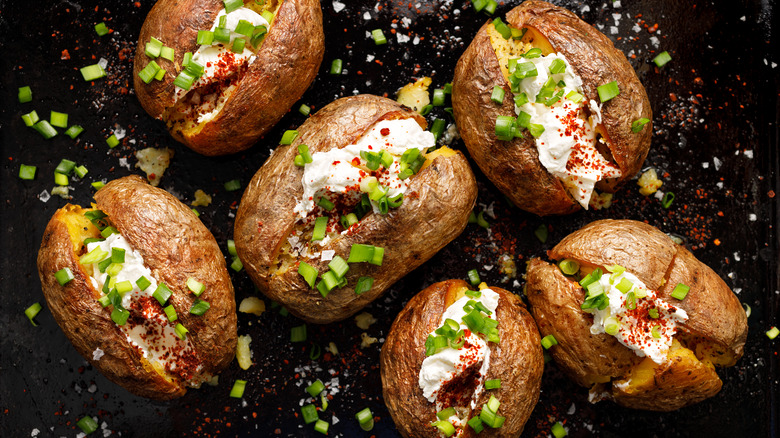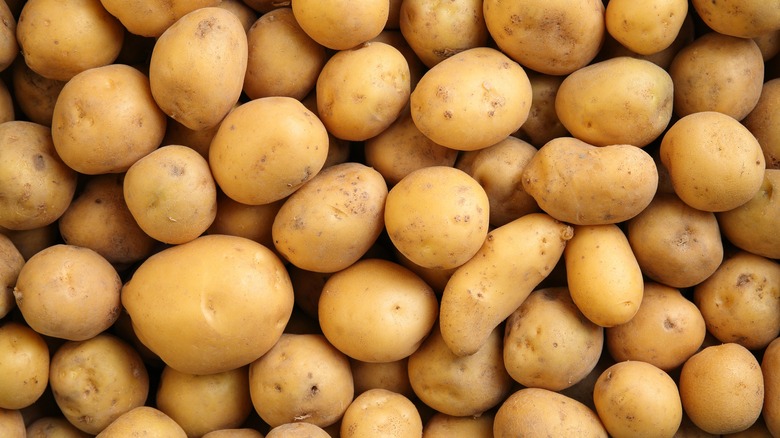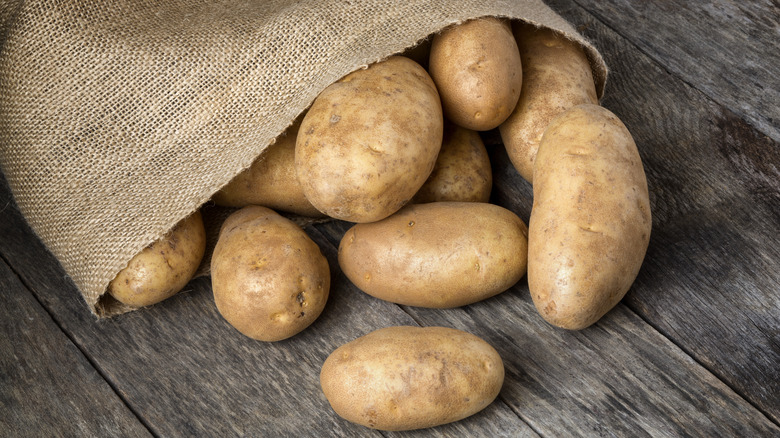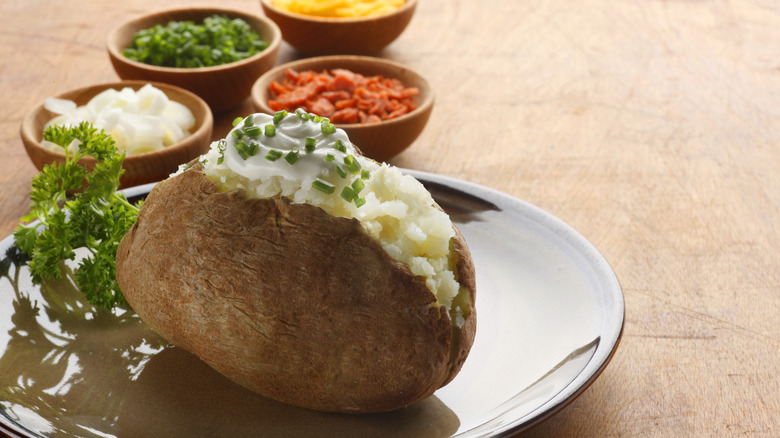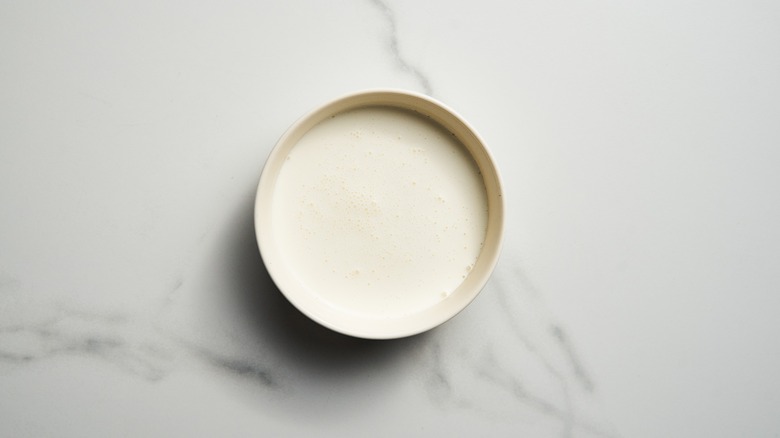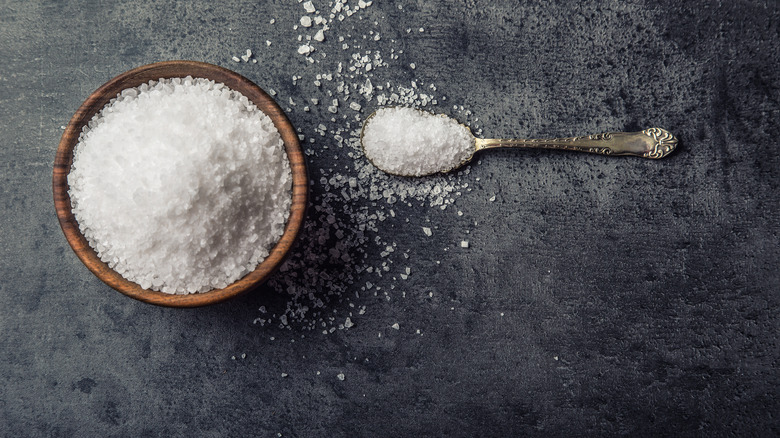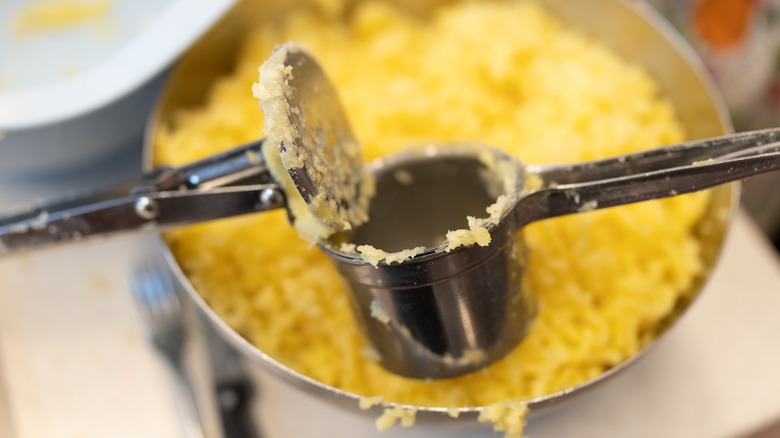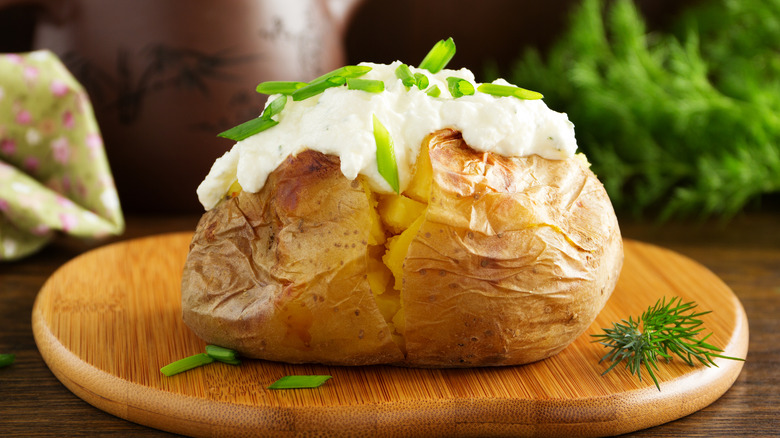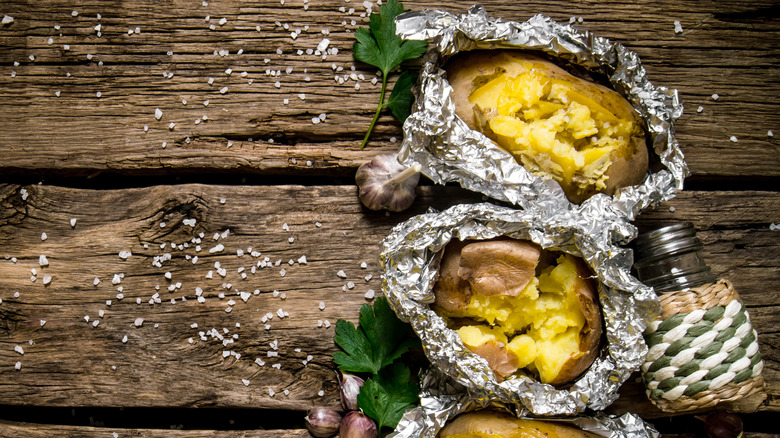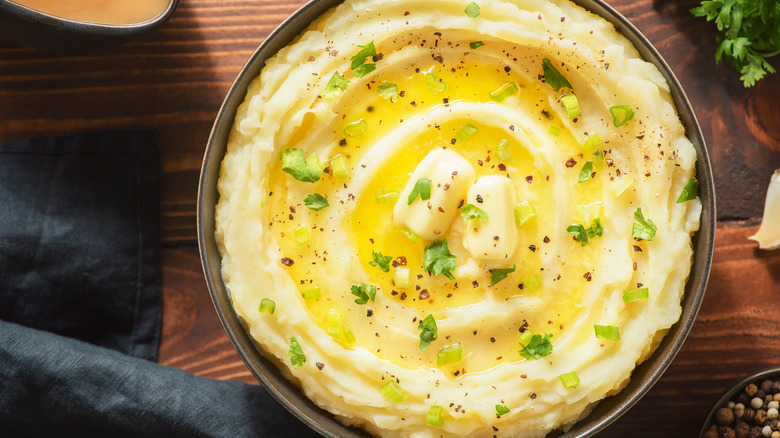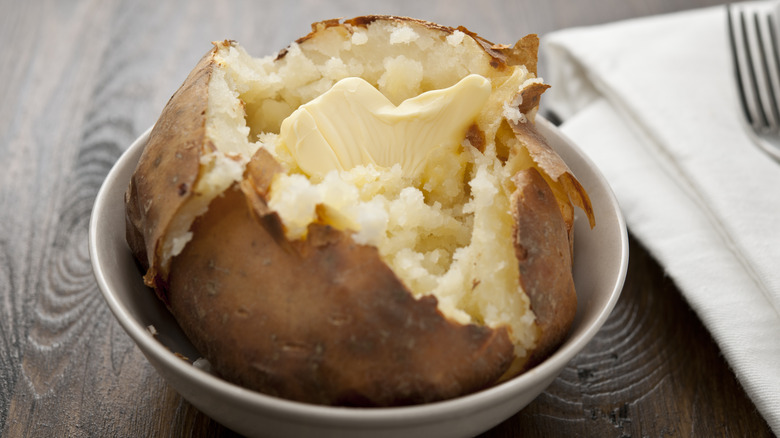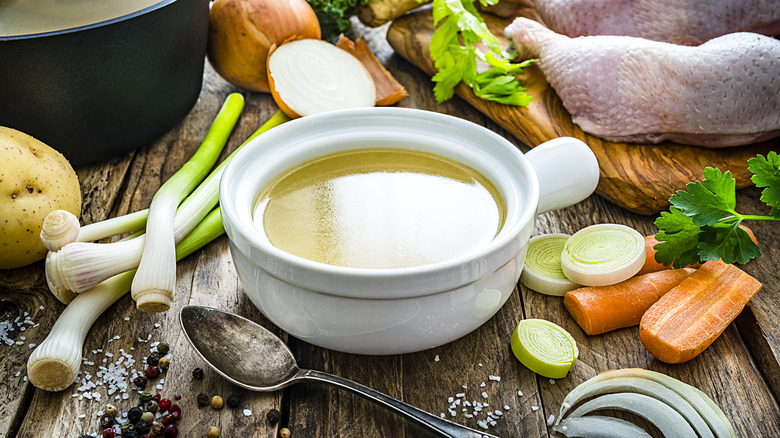Why Steakhouse Potatoes Always Taste Better Than Homemade
There's something about the combination of steak and potatoes that just works. Potatoes, with all their starchy goodness and creamy flavor, serve as the perfect base for the meaty, charred notes of steak to sit upon. Whether baked, mashed, or served in fried form, potatoes have a mildness that also pairs well with the sweeter, bolder flavors of sauces, and their fluffy texture combines wonderfully with the meat's chewy consistency. Simply put, they're the element that brings everything in a steak dinner together.
If you think that making steakhouse-worthy potatoes is easy, though, you're seriously mistaken. Potatoes might be simple enough to cook, but making them great is another story. Because their innate flavor is so gentle, it takes a surprising amount of balance and expertise to get them to pop without making them too salty or fatty. Luckily, steakhouse chefs put almost as much attention into these baked and mashed tubers as they do their steaks. We've decided it's time that these well-kept potato cooking secrets are shared with the world — and we've got them right here.
It all starts with the selection process
When cooking, you always want to start with the best items possible, even when you're working with something as simple as a potato. These tubers are pretty hardy and can last a few weeks at room temperature, or longer when kept in a cool, dark place. But, as with any vegetable, they deteriorate after hitting peak freshness. They're also fairly prone to becoming bruised or broken, which can hasten their decline. When potatoes start to get old, their flavor and texture can change, and they can become sweeter than you'd like. This process can also cause them to taste somewhat bitter.
Steakhouse chefs know these pitfalls well. Instead of trying to cook with old or dented potatoes, they always select the best spuds possible, beginning with how they feel. "You want a smooth and firm texture," advises Toups' Meatery's chef-owner Isaac Toups, per Today. Any potatoes that have gone wrinkly or developed soft spots are best avoided. You should also watch out for any stalks sprouting from your potatoes or any eyes that have developed, as these can indicate that your potato is getting older.
The chefs know the best potatoes to use
One of the main reasons why your potatoes might taste different than your favorite steakhouse's is that you're starting with an entirely different tuber. Potatoes come in a wide range of varieties, and each has a slightly different balance of starch, water content, and skin thickness. All of these factors can make a big difference in how tender they become when baked, as well as how crispy their skins get, among other details.
Steakhouse chefs generally stick to a few specific types of potatoes when making their spud-based dishes. "You should always start with russet potatoes," chef Sydney Willcox told Real Simple. Russet potatoes have excellent starch content and a thick skin, meaning they're particularly good for making soft and fluffy baked potatoes with a crispy outside. Yukon Gold is also a good variety for baked potatoes, thanks to its starchiness. For mashed potatoes, red potatoes are a common choice among steakhouse chefs. Not only do they mash up well and produce a creamy result, their skins give your mashed 'taters a pop of color and a gentle hint of nuttiness, providing an extra layer of interest that white potatoes don't always conjure.
Steakhouse chefs value consistency when cooking
Have you ever wondered how steakhouses produce perfect baked potatoes time and time again? It's because they've got the process down, folks. Steakhouse chefs tend to separate their potatoes by specific, nitty-gritty details, to avoid inconsistency. "I've found selecting potatoes that are similar in size helps them to cook more evenly in the oven or grill, while also ensuring they all reach the same level of 'doneness' around the same time," The Rex Steakhouse's executive chef Walter Nunez told Business Insider.
By doing this, steakhouses take the guesswork out of the cooking process. They also don't have to worry about taking certain potatoes out before others, plunging the oven's temperature and likely ruining some spuds in the process. This choosiness also prevents smaller potatoes from overcooking and developing a burnt underside. This tip is especially useful if you're cooking for a large group of people and want to get a consistent result on the table, without leaving some people waiting. However, it's also worth bearing in mind even if you're cooking just a few potatoes.
Heavy cream is a common feature
If you're not using heavy cream in your mashed potatoes, now's the time to start. What sets steakhouse mashed 'taters apart from the standard homemade recipe is a seriously generous glug of heavy cream. For a mashed potato recipe requiring four pounds of potatoes, steakhouse chefs will use about 1 1/2 cups of heavy cream to achieve a super-smooth, dairy-rich result. We know it's a lot, but don't be tempted to hold back here, folks.
Heavy cream has a weight and smoothness that other types of cream don't, and its unobtrusive dairy flavor pairs perfectly with potatoes without masking their natural taste. Because its flavor is mild, it operates as the perfect base for other additions, like garlic and parmesan, which add sharper, more savory notes. If you don't have heavy cream to hand, you can substitute it with half and half, or even milk in a pinch, but don't expect it to have the same flavor. You can also add cream cheese to your mashed potatoes for a texture boost and slightly tangy flavor. Luckily, folks who have a plant-based diet can get in on the steakhouse action here too. Simply substitute heavy cream for a plant-based cream alternative or cashew cream.
Chefs put salt on the outside of their baked potatoes
Breaking through a shatteringly crisp potato skin to get to the fluffy interior is one of the main draws of dining on a steakhouse spud, in our book. The secret to achieving this is a hefty dose of salt. Steakhouse chefs cover their baked potatoes in salt before sticking them in the oven, often helping the crystals adhere with a generous coating of oil. The reason for doing this is pretty scientific. When you put salt on the outside of a potato, it helps moisture come to its surface and evaporate, which makes the inside of the potato even fluffier. It also helps to crisp up the skin, giving it extra crunch.
You can use any type of salt you like on the outside of a baked potato, but the grains' size will affect things quite a bit. If you use fine salt like Morton table salt, you should be prepared for your potato to taste extra salty, as it will get more coverage — but the upshot is, that coverage may help more moisture get drawn out. Flaky sea salt, on the other hand, may give you a more gentle taste overall, but the shape of the grains means you may get some added crunch.
For mashed potatoes, the mashing process is pretty involved
Consistency is a big topic of conversation when it comes to mashed potatoes. While some steakhouses serve their mashed tubers with the skin still intact, most of them opt for a smooth-as-butter version. If you've ever tried to achieve silky mashed potatoes at home, though, you'll know that it's harder than it seems. So, how do steakhouse cooks do it? With more tools than you might think.
Steakhouse chefs first pass their cooked potatoes through a ricer, which breaks them down into tiny little pieces. Most home chefs would stop there, but in steakhouses, they then work these pieces through a mesh sieve after mixing them with butter and cream. This added sieving step breaks down all but the smallest grains of potato and turns the mash into a sturdy purée. It also helps the butter and cream to incorporate completely with the potatoes, preventing an unharmoniously-flavored dish. Naturally, this method isn't the easiest, and it takes a lot of elbow grease. It's worth remembering that when you consider the price of your mashed potatoes next time you're in one of the country's best steakhouses: You're paying for the hard work you'd rather not do at home.
Steakhouse baked potatoes are never microwaved
When you're making a mid-week meal, there's nothing wrong with making a perfectly baked potato in the microwave. In steakhouses, though, doing so is unheard of. Steakhouse baked potatoes are always cooked in the oven; doing so ensures that they get the perfect balance of crispy skin to fluffy insides.
The reason steakhouses never cut corners like this (even though it would probably make their lives easier) is because they understand the different types of heat produced by each appliance. Ovens use dry heat to cook food, and this dryness slowly and gently evaporates the water inside each potato, pushing it to the surface and drying out the inside. This results in a fluffier result, and way crisper skin. Microwaves, conversely, heat the water molecules in food directly, which causes water-rich items like potatoes to cook in mere minutes. However, this can come at the expense of its skin, which doesn't tend to crisp up at all in the microwave, instead becoming a little wrinkly, tough, and lacking in flavor. There's definitely a time and a place for a super-quick nuked potato, but it isn't a steakhouse. Having said that, if you're using the microwave to cook them at home, you can always throw them in the oven or under the broiler at the end to crisp things up.
Steakhouse chefs never wrap their baked potatoes in foil
A baked potato wrapped in foil is an iconic image often associated with steakhouses across the land. So it might surprise you to hear that chefs routinely advise against the practice. "I see a lot of people using foil to wrap their potatoes in but this is a big no-no and causes soggy skins!" chef Isaac Toups yold Today. The problem with using foil on the outside of your baked potatoes is that it acts as a barrier for the water inside the tuber, which you actively want to reduce as much as possible to make the potato fluffy. With nowhere for the water to escape, you end up with more of a boiled effect.
Using foil on the outside of potatoes also stops the oven's heat from getting to the skin directly, keeping it soft and soggy. Remember, you don't need foil on the outside of a potato to begin with: Placing it in a hot oven long enough will cook it perfectly adequately. While you can wrap your potato in foil after cooking it, bear in mind that this will soften it over time. It's far better to pop your potatoes in a bread drawer to keep them warm.
Steakhouses don't skimp on butter
It's no secret that butter makes almost everything better, and when it comes to potatoes, steakhouse chefs don't skimp. A huge amount of butter makes its way into steakhouse mashed potatoes, which gives them a luxurious, deep, full flavor. Although putting butter in mashed potatoes isn't exactly innovative, the ratio that steakhouse chefs employ is usually way different from what you might be used to as a home cook. While most people simply put a small pat of butter into a steaming pot of potatoes, steakhouse cooks aim for around a 10 to 1.25 ratio of potatoes to butter.
How the chefs add butter to their potatoes also makes a big difference. To make premium steakhouse-style potatoes, you should always add room temperature butter, and combine it with hot milk (or whatever dairy component you're using) when you throw it in with your tubers. By doing this, you allow the butter to emulsify with the other ingredients, incorporating them properly and making everything supremely creamy. Using cold butter can create too much of a temperature difference and stop the fat from blending properly with the carbohydrates and liquid.
Their baked potatoes are often way bigger
A steakhouse is the kind of place you go big within; these establishments simply aren't known for their subtlety or petite portions. This extends to their potatoes, too. Steakhouses generally buy way bigger potatoes than the kind that are available at your local supermarket. Some of the most famous steakhouses out there, like Ruth's Chris and The Capital Grille, serve baked russets that weigh in at about a pound apiece. The same goes for some local outfits, too.
For comparison's sake, know that the usual size of a loose potato in a supermarket is roughly 11 to 12 ounces, meaning that you're getting an extra 100 grams or so of potato-y goodness when dining at a fancy place. Generally, though, the cheaper a steakhouse, the smaller its baked potato will be. With a bigger potato comes the potential for more flavor, as every inch of its skin can be coated with salt or smothered with butter. While these bigger potatoes can be hard to find without a catering source at your disposal, Costco and Sam's Club are good places to start looking.
Chicken broth is often used for mashed potatoes
You can have the creamiest, fluffiest mashed potatoes around, but unless they're seasoned properly, they'll never hit the spot. This is something that steakhouses understand very well: Seasoning isn't just supplied by a dash of salt at the end. Instead, many chefs use chicken broth to make their potatoes and substitute it whenever water's called for. This starts before they mash the potatoes themselves: The experts often cook their raw potatoes in a basic chicken stock instead of water.
The logic behind this is simple: By cooking your potatoes in chicken broth, you allow them to soak up a huge amount of flavor. As a result, your potatoes season from the inside, bringing the mellow, savory tastes of the broth into the final result. You can then use more chicken broth to help loosen up your potatoes once they've been mashed or add any moisture that's lost to steam. Naturally, chicken broth can be pretty salty, so it's best to adjust how much salt you add to the recipe to compensate. It can also be a good idea to use low-sodium or sodium-free chicken broth, to add flavor without making your potatoes too briny.
